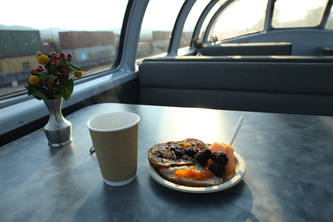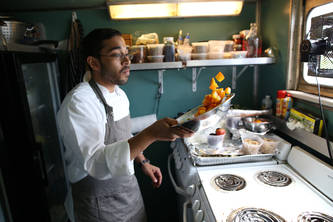Future Now
The IFTF Blog
My Transcontinental Journey to Explore our Food System
This article originally appeared in National Geographic’s special eight-month series on the future of food.
For 10 days this summer chefs Christian Ortiz, 29, and Simone Carvalho, 24, toiled away in the 30-square-foot kitchen of a renovated 1956 Pullman train car.

They were working to feed 35 ravenous young innovators on board the Millennial Trains Project, a series of crowd-funded transcontinental journeys on which young innovators explore our generation’s urgent challenges. My own project focused on the future of food systems so I paid close attention to our chefs. Managing waste, conserving water, and sourcing local foods, Ortiz and Carvalho demonstrated that it’s possible to create delicious, even decadent, food while also supporting a resilient food system.
Ortiz and Carvalho, who have Michelin-starred New York restaurants on their resumes, now run C.C.O. Consulting Group. They found their job on the train as any millennial working the gig economy might: in a Craigslist ad. The pair took it on as a “renegade culinary adventure”—the kind of creative risk they encourage their clients to take. Along with the rest of the ten-day journey’s participants, the chefs were tasked with finding inspiration in the diverse landscapes and communities and applying that to a project—in their case, daily meal preparation. Inside the train, Ortiz and Carvalho both reconnected with age-old practices and pointed toward future possibilities for our food system.
On the train myself, I observed all of this from the perspective of a researcher and designer at Institute for the Future. We help individuals and communities think systematically about the future. Part of this process is to create environments and experiences that enable people to understand the long-term effects of their actions. The train did just that. It became a microcosm for our world at large where we could easily understand how finite our resources are. For example, everyone became water conservationists because if the tanks ran out of water before the next filling station, our whole community would be affected.
The necessities of train travel led the chefs to act in ways, which, if scaled, could create a more resilient food system. Here are a few of those practices.
Managing Waste
As we finished our grilled pork chops in Whitefish, Montana, Carvalho made a request. We had started the trip with enough paper cups to last the duration, but three days in we were already running low. People weren’t being intentionally wasteful, but as is often the case, once trash is out of sight, it’s out of mind.
“Your waste doesn’t magically disappear,” Carvalho said. She described the one, small closet in the lounge car hallway where all of the trash bags were stuffed. We understood that we either needed to curb our rapid cup consumption, or else live among bags of trash. We also realized that once we got off the train, our waste was slowly filling up our planet’s “trash closet,” too.
 Food waste was less of a problem. The chefs created consistently delightful and inventive foods and even picky eaters scraped their plates clean. Carvalho would stand under the glass dome of the observation deck and announce their creations to the crowd. They often creatively repurposed of the previous meal’s ingredients. Leftover figs were turned into fig basil jam. Roasted golden beets appeared in the next morning’s juice. Kohlrabi showed up in the frittata and bread was resurrected as pain perdu. With just two small refrigerators on board, the train created an imperative to manage food inventory in a way that most commercial kitchens do not.
Food waste was less of a problem. The chefs created consistently delightful and inventive foods and even picky eaters scraped their plates clean. Carvalho would stand under the glass dome of the observation deck and announce their creations to the crowd. They often creatively repurposed of the previous meal’s ingredients. Leftover figs were turned into fig basil jam. Roasted golden beets appeared in the next morning’s juice. Kohlrabi showed up in the frittata and bread was resurrected as pain perdu. With just two small refrigerators on board, the train created an imperative to manage food inventory in a way that most commercial kitchens do not.
Sourcing Locally
In the month before our departure, Ortiz and Carvalho spent more than 100 hours researching in-season foods and finding purveyors at each stop. Sprawling spreadsheets mapped out ingredients, from 20 pounds of salmon (line-caught by a Yakama tribesman) to dozens of pounds of fresh greens, and almost 500 eggs from free-range chickens.
By sourcing from smallholder farmers, the chefs supported local economies and resilient production practices. Even with only a few hours to shop in each city, they didn’t take shortcuts by stocking up at supermarkets. They committed to showcase our country’s diversity and make regionally inspired fare with local ingredients.
Remaking Food Culture
During the golden age of American rail travel, the dining car was the central attraction. Unlike the processed and packaged foods of today, the elaborate meals consumed on the trains were prepared from scratch. The disappearance of opulent dining cars parallels the last century’s shift toward cheap, standardized, and convenient foods. The Millennial Train proved a testing ground for reversing those trends. It instilled a respect for the lands and people that produce our food as we rolled past thousands of acres of farms. It also catalyzed community each time we squeezed three-deep into the dining car booths.
If a return to a slower, more intentional form of cross-country travel can cultivate and spread innovative ideas, it can also set the course for reimaging our daily food practices.
With the help of Ortiz and Carvalho, our Millennial Train participants emerged from the journey with an understanding that with every food choice we make—from reducing waste to knowing our farmers and sharing meals with friends—we are actively making the future.
Photographs by Tyler Metcalfe for National Geographic.
This post is part of IFTF’s food futures research, which brings systematic futures thinking to food system efforts around the world. Our long-term view encompasses multiple scales, levels of uncertainty, and radically different possible futures. We develop foresight to help others develop insight and take action toward impactful, transformative, resilient change.For more information about our research, sponsorships, collaborations, and events, please contact Rebecca Chesney at [email protected]



